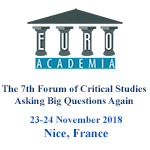Euroacademia Conferences
 Europe Inside-Out: Europe and Europeanness Exposed to Plural Observers (9th Edition) April 24 - 25, 2020
Europe Inside-Out: Europe and Europeanness Exposed to Plural Observers (9th Edition) April 24 - 25, 2020 Identities and Identifications: Politicized Uses of Collective Identities (9th Edition) June 12 - 13, 2020
Identities and Identifications: Politicized Uses of Collective Identities (9th Edition) June 12 - 13, 2020 8th Forum of Critical Studies: Asking Big Questions Again January 24 - 25, 2020
8th Forum of Critical Studies: Asking Big Questions Again January 24 - 25, 2020 Re-Inventing Eastern Europe (7th Edition) December 13 - 14, 2019
Re-Inventing Eastern Europe (7th Edition) December 13 - 14, 2019 The European Union and the Politicization of Europe (8th Edition) October 25 - 26, 2019
The European Union and the Politicization of Europe (8th Edition) October 25 - 26, 2019 Identities and Identifications: Politicized Uses of Collective Identities (8th Edition) June 28 - 29, 2019
Identities and Identifications: Politicized Uses of Collective Identities (8th Edition) June 28 - 29, 2019 The European Union and the Politicization of Europe (7th Edition) January 25 - 26, 2019
The European Union and the Politicization of Europe (7th Edition) January 25 - 26, 2019 7th Forum of Critical Studies: Asking Big Questions Again November 23 - 24, 2018
7th Forum of Critical Studies: Asking Big Questions Again November 23 - 24, 2018 Europe Inside-Out: Europe and Europeanness Exposed to Plural Observers (8th Edition) September 28 - 30, 2018
Europe Inside-Out: Europe and Europeanness Exposed to Plural Observers (8th Edition) September 28 - 30, 2018 Identities and Identifications: Politicized Uses of Collective Identities (7th Edition) June 14 - 15, 2018
Identities and Identifications: Politicized Uses of Collective Identities (7th Edition) June 14 - 15, 2018
‘Tell All The Truth But Tell It Slant’: Recovering Angela Davis’ presence in Robert Barry’s Marcuse Piece
-
-

-
Presentation speakers
- Sandrine Canac, Stony Brook University, New York, USA
Abstract:
This paper considers the Marcuse Piece, a 1970 text-piece by the Conceptual artist Robert Barry, as a site of conflictual encounters. In this work, which reads “Some places to which we can come, and for a while “be free to think about what we are going to do,” Barry’s own words meet Marcuse’s, or as I argue, words that invoke the invisible presence, the political struggles, and intellectual contributions of Angela Davis. Davis has remained unnamed in an Essay on Liberation (1969), the book written by the German philosopher and New Left theorist Herbert Marcuse from which Barry excerpted the quote. Davis has not only remained unnamed in Marcuse’s text and in Barry’s work, but has also been absent from the interpretations of Barry’s Marcuse Piece. Recovering Davis’s presence brings to the fore political contexts such as the Black liberation and prison abolition movements that have been ignored in traditional histories of Conceptual art because their very objects–the artists and their works¬–were themselves oblivious to these contexts. This paper proposes unexpected sites of resistance in Barry’s Marcuse Piece, which allow us to rethink the meaning and the history of Conceptual Art in the United States.
-
Related Presentations













